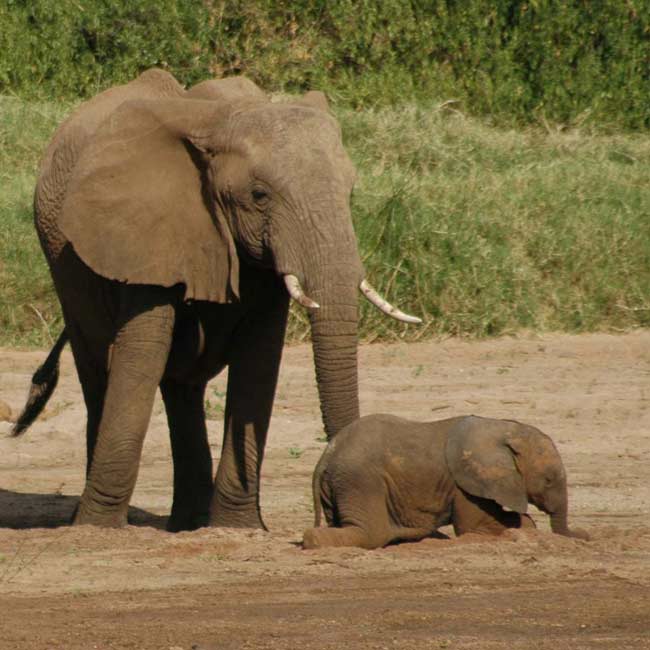The Perils of Being Huge: Why Large Creatures Go Extinct

Once upon a time, a 2-ton wombat lumbered across the Australian Outback. Around the same time, mammoths and saber-toothed tigers had the California coastline all to themselves.
Millions of years before any of these animals existed, Tyrannosaurus rex and other colossal dinosaurs ruled the world.
These and some of the other largest and most fantastic creatures ever to walk the planet are long gone, victims of mass extinctions of large beasts. And for reasons poorly understood, often the animals to fill the voids were tiny by comparison.
Predisposed to extinction
Scientists generally accept that a giant asteroid slammed into the Gulf of Mexico some 65 million years ago, setting off a chain of catastrophic events that ultimately led to the extinction of dinosaurs. Whether or not an asteroid is to blame, the so-called KT boundary in the in fossil record displays a mass extinction of dinosaurs and other large animals around the world.
Small scavenging mammals and birds survived the event, and scientists can't say for sure why dinosaurs did not.
Since bigger beasts couldn't take shelter in small protected burrows, perhaps they were done in by fierce environmental conditions. Or maybe with so many plants dying off, big herbivores simply had nothing to eat, and as they died out, so did the big carnivores.
Sign up for the Live Science daily newsletter now
Get the world’s most fascinating discoveries delivered straight to your inbox.
Or perhaps with all the stress, dinosaurs simply couldn't reproduce quickly enough to keep up with sexually nimble mammals and were soon outnumbered.
"If a disease or climate impact is severe enough to kill off most of the young in a generation, it will take a very long time to replace them," zoologist Alex Greenwood of Old Dominion University told LiveScience. "Smaller mammals like rodents, for example, would not be as severely affected since they have multiple young and a very short birth cycle."
Along with mammals, turtles and crocodiles, which can lay hundreds of eggs at a time, managed to survive the mass extinction. Also, because they could take shelter in water, these reptiles probably weren't competing with land mammals for resources.
A mammoth lesson
Then mammals got bigger. And eventually they paid the price.
Several mammoths and other big mammals died off during the Pleistocene/Holocene extinction event, which started around 50,000 years ago and continued through the end of the last major ice age about 10,000 years ago.
Today's large mammals— often with small populations, long gestation periods and late weaning ages—are similarly predisposed to sudden mass extinction, scientists say. For big beasts, taking care of offspring is typically a time sink and an energy drain, and the whole setup makes the young highly susceptible to predation.
Large mammals are also slow to reach sexual maturity, and mortality rates before that age are generally high. The slow pace at which new individuals are introduced to the population presents an obvious challenge to enduring tough times when population numbers drop precariously low.
Super predators
Mass extinctions occur with surprisingly regularity over the long haul. During the last 250 million years, there's been a big die-off roughly every 26 million years.
Adam Lipowski, a researcher at Adam Mickiewicz University in Poland, suggests the extinctions might sometimes be driven not by climate change or impacts from space, but by the emergence of super predators.
In 2005, Lipowski developed a computer simulation representing a population of many species competing for food and living space. Much of the time, "medium efficiency" predators prowled the virtual world and their numbers fluctuated only slightly in response to changes in prey population size.
But every so often, mutations would lead to the evolution of a super predator that quickly devours an entire prey population, which in turn leads to its own extinction.
The critters that survived the "predatory apocalypse" gradually mutated to fill new ecological niches, and the cycle began anew.
Look in the mirror
Humans could be considered today's super predators.
We've been implicated in the extinctions of mammoth, various saber tooth cats, and giant apes, as well as more recent extinctions of dodos, bonobos, and wild horses. Whether human hunting pressure, climate change or other factors were responsible remains controversial, however.
Meanwhile some whale species, among the biggest mammals that ever lived, have seen their populations drop to mere thousands in response to over-hunting and environmental pressures. Scientists estimate only about 300 North Atlantic right whales exist, with much of the attrition attributed to collisions with large shipping vessels and noisy ports causing navigational confusion.
Illegal poaching and habitat reduction have cut African elephant numbers in half, to 600,000, in the last 30 years. Scientists have determined that African lions'historic distribution has shrunk 82 percent in the last few decades and the wild population is estimated in only the low tens of thousands. And although Florida manatee numbers have nearly tripled in the last 15 years, the population hovers around just 3,000.
Humans can also initiate extinctions inadvertently.
Between 55,000 and 45,000 years ago, humans first set foot on Australia. At the time, large emu-like terrestrial birds and oversized wombats roamed the continent. But when humans started setting fires to clear land or flush prey from bushes, they also stripped the land of many of the plants the large animals favored.
Many of the smaller animals that adapted to eat the remaining plants survive today, while the two-ton wombat is no more.









